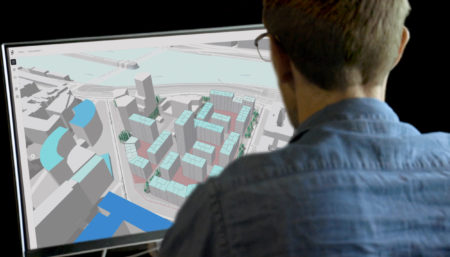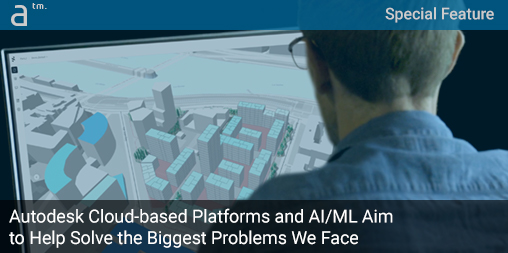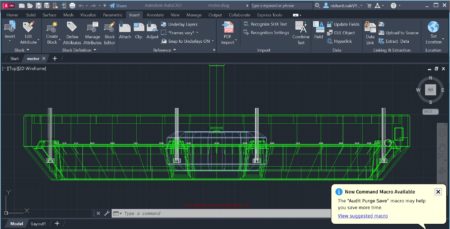AT AUTODESK UNIVERSITY 2022 THIS YEAR, we heard about how the company is going all-in on cloud-based platforms, moving more and more market-leading applications to the cloud.
So what does this all mean for the future of design and engineering? Amy Bunszel, executive vice president, Architecture, Engineering, and Construction Design Solutions, shared her thoughts on that question, and in this article, we delve into what it all means.
First and foremost, we heard during AU22 how cloud-based platforms became more critical during the global pandemic years and how work isn’t going back to how it was before 2020. Of course, that too presents another kind of problem, one that the late Apple co-founder Steve Jobs was hoping to quell with its amazing Cupertino, California campus and circular spaceship-like main building.
Immersive, real-time virtual technologies will power innovations in remote collaboration, allowing AEC professionals to see, touch, and hear their way to the best possible design regardless of their physical location.
While remoteness is the new norm and cloud platforms like Autodesk Forma will present the new answer for connection despite geography, companies like Autodesk will have to figure out how to create the serendipity Jobs prized so highly for spawning innovation. And while “walking meetings” have further been proven beneficial to “creativity” and overall health, it will take a company like Autodesk (or perhaps more fittingly Apple) to find a way to replicate virtually those benefits.
Autodesk and the Connected World
So how can a company like Autodesk encourage innovation in the post-pandemic world?
Amy Bunszel believes remote work is our new reality. The company is focused on how this kind of virtual connection can foster collaboration. “Immersive, real-time virtual technologies will power innovations in remote collaboration,” says Bunszel, “allowing AEC professionals to see, touch, and hear their way to the best possible design regardless of their physical location.”
In the spirit of Jobs’ chance encounters philosophy, Autodesk is now touting the values of “cross-connections” that become possible when digital working environments are wide open. Openness has several levels of consideration, but one level is the flexibility of devices users want to have and low barriers to entry. “We recently launched AutoCAD Web,” says Bunzel, “which provides access to collaborative workflows and brings teams together no matter where they are, all without requiring them to download software.”
Moving applications to the cloud is one thing, but building cloud platforms that enable multiple applications—even those not created by Autodesk—to share and connect with data is another bold step focused on enhancing collaboration through a more robust connection infrastructure.
Autodesk Forma will create better customer outcomes and solve issues around disconnected data, automation, and collaboration opportunities.
The new Autodesk Forma and today’s Spacemaker focus on these two values. “Autodesk Forma will create better customer outcomes and solve issues around disconnected data, automation, and collaboration opportunities,” says Bunszel. And with Spacemaker today, she adds, “customers can test their concepts and optimize design plans faster than before by identifying and fixing challenges that may otherwise arrive later in the design process.”
But the question of serendipity and its role in the virtual world remains largely unresolved. This is where Autodesk’s collaboration work with Epic Games may come into play in the future or where the innovative team from The Wild, a VR software company that Autodesk acquired recently, will help address. And it still needs to be determined if the value of chance encounters plays equally into the importance of innovation in an AEC company as much as it might in a tech software company.
Lessons for AEC from M&E and the new Cloud Systems
One thing for sure is that we now know the remoteness and lessons of the pandemic bear out differently across industries and that companies serving multiple industries, as Autodesk does, can cross-pollinate ideas and best practices.
“Across all industries,” says Bunszel, “we see a future of cloud-based, artificial intelligence-powered convergence. Data experiences will be simplified, interoperable, and intuitive.”

This GIF animation shows Autodesk Spacemaker in action. This technology forms the basis for the future Autodesk Forma.
Bunszel says that the media and entertainment (M&E) industry has had some of the most disruptive transformations during the pandemic when ironically, content demand rose on the consumer side simultaneous to the pandemic disruption. “We are currently harnessing the cloud to provide connected workflows upstream in production,” she added. “And with Moxion, studios are capturing content on set at a critical point in the film and TV production process when the bulk of raw production data is generated, and creative decisions are made that have a significant impact during post-production.”
Bunzel says that what has happened and is happening in M&E is beginning to occur in AEC thanks to cloud-based platforms that foster better collaboration between various teams no matter where they are located. “This also improves efficiencies across the entire lifecycle,” she adds. “For example, with our AutoCAD and Autodesk Build integration, construction crews stay up-to-date on the latest design changes while working on-site. Similarly, Revit cloud worksharing allows teams to collaborate on Revit models in the cloud through co-authoring cloud models and centralizing all project data into a single source of truth.”
New Connections Between D&M and AEC
Convergence is another critical theme in technology-driven industries like AEC, and it predates the global pandemic. Bunszel says that new connections between design and manufacturing (D&M) and AEC will flourish in the years to come, and over the past few years, there have been great examples.
“We’ve seen many examples of AEC firms like AECOM to BAM Construction to Bryden Wood applying manufacturing techniques to building workflows,” says Bunszel. “These firms report exceptional outcomes from improved certainty to increased productivity and sustainability.”
It’s important to notice the value of those three words italicized above. We can measure sustainability today; productivity is more challenging to measure in AEC, while certainty is even more difficult to measure and far less understood. Data-enriched, cloud-based tools can best produce insights on these three measures as critical KPIs (key performance indicators). It is precisely KPIs that have been better understood and measured in the design and manufacturing world.

Spacemaker in action offers AI-assisted pre and early-phase design via AI-generated outcome-based design solutions.
Autodesk is working to drive increased synergies between D&M and AEC. Connecting people, processes, and technology through design for manufacturing and assembly (DfMA) workflows involves leveraging data, automation, and insights. “These workflows will give AEC firms real-time feedback to speed-up decision-making, accelerate delivery, and reduce waste in operations,” she adds.
Bunszel says a good case study is by Bryden Woods and their Forge-based commercial project in London. “The productization of building components and manufacturing-informed design enabled the complex to generate 30 percent less embodied carbon than in a normal construction building,” says Bunszel. “As a result, it’s the first building to meet the UK Green Building Council’s definition of a net-zero office building.”
Digital Twins: A Planet-Saving Technology
And speaking of saving the planet, Autodesk’s future cloud-driven technologies also involve the use of the “digital twin”—a virtual model that accurately reflects its physical, real-world counterpart. Digital twins are not just digital replicas of a physical asset; they embody the data about that asset’s history from design inception through operations—the asset’s lifecycle.
“We believe that addressing the risks of climate change and building sustainable solutions is imperative across every aspect of the AEC industry and throughout the building asset lifecycle,” says Bunszel. “That cycle begins with pre-design and extends through operations and even decommissioning.”
The biggest way AI/ML will affect us in the future is in how we interact with technology. AI will become a valuable partner in the design process.
“Digital twin technology is a critical and growing part of the solution,” she adds, “but to be clear, [a] digital twin is better when a good BIM process is followed—it does not operate as efficiently on its own.”
Force Multipliers: AI and Machine Learning
While digital twins are an emerging technology, their power is greatly amplified by another critical emerging technology in the AEC industry: artificial intelligence and machine learning.
Digital twins will intelligently capture and process sensor data about building assets. Then AI/ML will analyze that data for intelligent insights to be used at the front end of the design process for those same building assets.
“The biggest way AI/ML will affect us in the future is in how we interact with technology,” says Bunszel. “AI will become a valuable partner in the design process.”
Artificial intelligence (AI) will do many things to improve design process outcomes, but perhaps one of the most compelling will be process dataflow from the end users of systems. And systems can be anything from your smartphone or an app to whole buildings. At the software app level, AI can learn how to anticipate and predict the user’s intent and give way to fostering a relationship with the user such that the user trusts these intelligent systems to automate tedious tasks intelligently.
An example already exists in AutoCAD 2023, whereby AI improves workflows. “In AutoCAD 2023, we introduced the Macro Advisor—driven by the Autodesk My Insights advisory engine, which extracts and analyzes usage patterns,” says Bunszel. “It can identify repetitive tasks and surface new macros designed to save time. This will amplify our customers’ creativity by giving them more time for the more creative aspects of their work,” she adds. In short, AI/ML will be a force multiplier for creatives in the long run.
A Smart House in 2035
Having a chance to talk with Bunszel about the AEC industry would only feel complete with asking her to project the future of the smart home. Bunszel isn’t just an Autodesk executive—she’s a proven successful entrepreneur. Before Autodesk, she co-founded Linius Technologies, which was acquired by Autodesk in 1996 and whose technologies were integrated into Inventor.
MORE: Autodesk AutoCAD 2023—AI, Upskilling Users and Performance
Bunszel is also responsible for transforming the company’s best-selling AutoCAD product into the modern, multi-platform offering it is today. So what does she think about the smart homes of the future?
“I expect that by the middle of the 21st century, we will live, play, and do business in buildings designed to nourish the environment rather than take from it,” she says. “Like what was imagined on ‘The Jetsons’ or ‘Star Trek,’ rooms will automatically adapt their lighting and temperatures to the ideal levels when occupied and reduce usage when they are empty,” she predicts.
“Using increased amounts of IoT sensor data, actual performance data can provide insights back into optimizing the next building design and its equipment so that the building process will become more circular,” she adds.
Like what was imagined on ‘The Jetsons’ or ‘Star Trek,’ rooms will automatically adapt their lighting and temperatures to the ideal levels when occupied and reduce usage when they are empty.
Autodesk today is developing the seeds of this technology in multiple sectors, from design and manufacturing (D&M) and AEC (architecture, engineering, and construction) to media and entertainment (M&E). “Our vision,” she says, “for cloud-based platforms that combine AI and automation will improve collaboration and efficiencies across teams to help solve the biggest challenges we face.”






Reader Comments
Comments for this story are closed